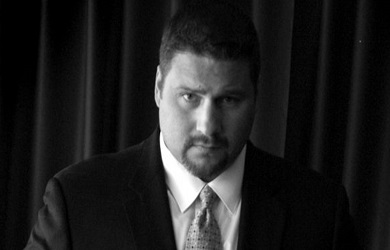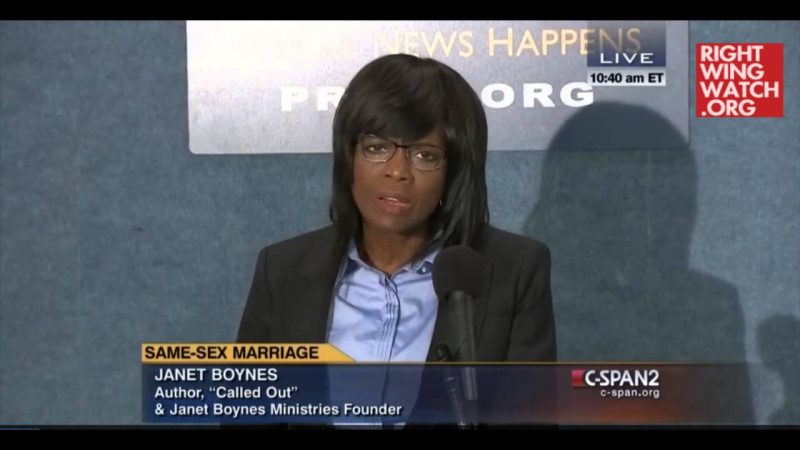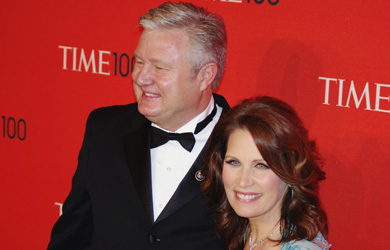Newsweek is out today with a story on John Paulk, who was featured on the magazine’s cover as an ex-gay success story back in 1998, and other ex-gay activists who have since recanted and left the movement.
Newsweek’s story reveals the personal struggles that many ex-gay leaders faced, even as they aided a movement that was harmful to gay people, particularly minors. The ex-gay movement, after all, was a product of a larger Religious Right push to undermine the claims of gay rights advocates by depicting homosexuality as a choice or a set of feelings that could be easily “fixed.”
Paulk’s ex-wife, Anne Paulk, however, continues to toe the ex-gay line.
Far-right groups including the Family Research Council and the American Family Association pooled $600,000 to place ads promising the effectiveness of reparative therapy in The New York Times, USA Today, The Washington Post, The Wall Street Journal, the Los Angeles Times, and the Chicago Tribune. Anne and John Paulk smiled from full-page newspaper spreads.
In front of the crowds and cameras, Paulk was the image of certainty. But backstage, he was faltering. More than that, he knew he was lying.
“It’s funny, for those of us that worked in it, behind closed doors, we knew we hadn’t really changed,” he says. “Our situations had changed—we had gotten married, and some of us had children, so our roles had changed. I was a husband and father; that was my identity. And the homosexuality had been tamped down. But you can only push it down for so long, and it would eke its way out every so often.”
When Paulk walked into that gay bar in 2000, someone recognized him and phoned Wayne Besen, a gay rights activist who now runs the nonprofit Truth Wins Out. Besen rushed over and snapped a picture. In the ensuing scandal, Paulk initially claimed he just went in to use the bathroom, and didn’t know it was a gay bar. But really, he was aching just to be in a welcoming environment.
“I went to a gay bar—not looking for sex, which is what people thought—but because I was missing my community. I was looking to sit in a place with people I felt comfortable with, and that was other gay people,” Paulk says. Though he continued to take speaking engagements, by 2003, he was burned out.
“I would be in hotel rooms, and I would be on my face sobbing and crying on the bed,” he says. “I felt like a liar and a hypocrite. Having to go out and give hope to these people. I was in despair knowing that what I was telling them was not entirely honest. I couldn’t do it anymore.”
Even in its earliest days, Exodus’s philosophy—that same-sex attraction meant a person was “broken” and could be “fixed”—was undermined by the reality of its members’ actions. Michael Bussee and Gary Cooper, two of the co-founders, left the movement in 1979 to be in a committed relationship with one another. (Bussee has spent the decades since actively fighting Exodus’s message.) John Evans, one of the founders of Love in Action (LIA), an early ex-gay ministry that helped establish Exodus in 1974, left LIA after a friend committed suicide over his distress at being unable to change his sexual orientation. “They’re destroying people’s lives,” Evans told The Wall Street Journal in 1993. “They’re living in a fantasy world.” (LIA has since changed its name to Restoration Path.)
…
First came the photo of Paulk in the gay bar. Then in 2003, Michael Johnson, founder of “National Coming Out of Homosexuality Day,” was revealed to have infected men he’d met on the Internet with HIV through unprotected sex. John Smid, who joined LIA in 1986 and eventually became its executive director, left the organization in 2008. Three years later, Smid wrote on his blog that he “never met a man who experienced a change from homosexual to heterosexual,” and that reorientation is impossible, because being gay is intrinsic.
Then it crumbled further. In 2012, psychologist Robert Spitzer—one of the leaders of the successful push in the 1970s for the American Psychiatric Association to declassify homosexuality as a disease—retracted a controversial study, published in 2003, often cited by the ex-gay community that had concluded some “highly motivated” individuals could change their sexual orientation. Spitzer wrote an apology to LGBT people who “wasted time and energy” on reparative therapy.
…
Lastly, there’s the National Association for Research & Therapy of Homosexuality (NARTH), founded in 1992 by psychologist Joseph Nicolosi. NARTH considers itself the foremost secular proponent of conversion therapy; it counts hundreds of well-credentialed mental health professionals among its ranks and has issued a number of white papers on the subject. It too, however, has suffered in the public eye in recent years: In 2007, NARTH therapist Chris Austin was convicted of sexually assaulting a client, and sentenced to 10 years in prison; in 2010, NARTH board member George Rekers was found to have employed a male prostitute as a companion for a two-week European vacation; and in 2012 the Internal Revenue Service revoked NARTH’s nonprofit status for not properly filing its paperwork.
Paulk left Exodus in 2003. He cautions against “speaking for everybody,” but says in his more than two decades of watching people undergo ex-gay therapy, the “large majority” of people he met “did not change one iota.” Paulk remained silent for a decade, until he issued a formal apology last year. “I know that countless people were harmed by things I said and did in the past, ” Paulk wrote in a statement. “I am truly, truly sorry for the pain I have caused.”








